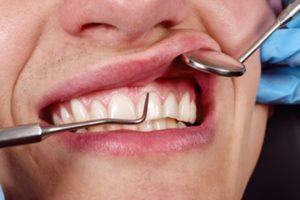
Your smile is one of the first things that people notice about you—so knowing that your pearly whites look their absolute best will go a long way towards making great first impressions. But your teeth aren’t the only noticeable part of your smile; your gums are often visible and admirable, too! That said, if you’ve recently discovered a bump on your gums, you’re probably wondering what it is and what you need to do about it. Here are some of the common causes for bumps appearing on your gums, along with some signs for when you should see your dentist about it.
Common Culprits for Bumps on Gums
Many people experience gum pain or irritation at some point, but in certain cases, it can lead to a bump forming. This can result from several different things:
- Cyst – A cyst is a small bubble filled with air, liquid, or other soft materials. They often grow slowly and rarely cause any symptoms, although they can sometimes become infected and painfully swell up. This is usually easily treatable through a small surgical procedure.
- Abscess – Abscesses are caused by bacterial infections, and they’re usually pretty painful. They’re filled with pus and will need to be drained before your dentist can treat the source of the infection.
- Fibroma – Fibromas are noncancerous lumps that develop on irritated gum tissue. They’re usually painless and feel like hard, dome-shaped lumps or dangling skin tags. Normally, they don’t require any treatment.
- Canker sore – A canker is a small, painful ulcer that can form at the base of the gums. However, they usually heal on their own within a week or two, and over-the-counter analgesics can be used to help with the pain.
- Pyogenic granuloma – These are red bumps that appear swollen and blood-filled, and they’re removed via surgery. Even though dentists aren’t sure what causes them, it’s thought that minor injuries and irritation play a role, as well as hormonal changes that occur during pregnancy.
- Mandibular torus – This is a common bony growth that can appear in the upper or lower jaw, occurring either alone or in clusters. But they grow slowly and rarely require treatment.
- Oral cancer – A cancerous tumor might appear as a small growth or lump, and your dentist can perform a quick gum biopsy to determine if the growth is malignant. Associated symptoms usually include tongue and jaw soreness, loose teeth, trouble chewing and swallowing, red/white patches on the gums, and more.
Should I See My Dentist About a Bump on My Gums?
Even though bumps on your gums are often nothing too severe, it’s still in your best interest to contact your dentist if you experience any of these symptoms:
- Throbbing mouth pain.
- Sores that don’t heal or progressively worsen.
- Red or white patches inside your mouth or on your lips.
- Lumps that don’t disappear after a few weeks.
- Constant bad breath or a foul taste in your mouth.
- Fever.
Bumps can appear on your gums without warning, and the cause is rarely obvious! That said, visiting your dentist upon experiencing any of these symptoms will ensure that a potentially serious oral health issue isn’t given the chance to develop.
About the Author
Dr. Rob Wood has proudly served patients and families in Salt Lake City for several years. Dr. Wood attended the Temple University Kornberg School of Dentistry and is an active member in multiple professional organizations including the American Dental Association and the Utah Dental Association. He is also a board-certified periodontist! If you have any questions about the article or would like to arrange a visit, you can contact Dr. Wood through his practice’s website or over the phone: (801) 322-5032.
